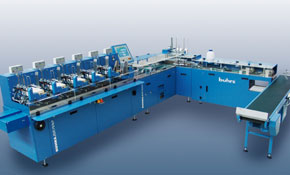First unveiled as the Ultimail in 1999, the 4000 series of film and paper wrapping lines were developed amid an environment of fierce competition in the mailing sector, between rival mailing houses and printers offering in-house mailing services.
Film and wrapping is still considered a commodity service, but that hasn’t stopped Buhrs’ flagship unit from notching up 100 installations. There have been 15 installations in the UK and the 4000 has been constantly enhanced since it hit the market.
Originally, it was targeted at direct mail and catalogue finishers, but the revamped 2006 version has expanded its appeal to a wider range of printers. According to Buhrs, one of the main strengths of the machine is that it can be configured to the customer’s demands, thanks to a raft of optional extras including extra feeders for mail sorting, pre- and post-wrap, gimmick feeders, stackers, autoloaders, intelligence cameras and the BuhrsWrap.
Control of wrapping
Using less polywrap than standard wrapping methods, the BuhrsWrap system enables the user to control and monitor the unwinding and stretching process of the film – so much so that the product is tightly wrapped without limiting the net output of the system.
“It’s a servo-driven machine with a high degree of automation,” says John Ricketts, Buhrs UK managing director. “You can store set-ups on the machine, which helps you with quicker set-up times.”
There are four models in the range: the 4000 for catalogues and direct mail; the 4200, a wide-body machine for newspapers; the 4500, an inserting machine for books; and the 4700 for retail brochures. Although the focus of the machines is on unaddressed mail, all four can be equipped with inkjet heads for addressing if necessary.
The first big changes to the machine came in 2003, when the wrapping module also became servo-driven. In 2006, Buhrs added Automatic Feeder Synchronisation (AFS). Because the average door-drop pack contains several products of varying formats, the feeders are designed to feed all variations without stopping, through sensors that automatically detect the product dimension.
“Changes can be retrofitted on the machine – it’s just a matter of cost. But sometimes it isn’t commercially viable to upgrade. It can be better just to buy new,” says Ricketts. Spare parts can be ordered from its production factory just outside of Amsterdam or from the UK.
“We take machines as part-exchange, but they tend to last a long time and get snapped up very quickly,” adds Ricketts.
Buhrs has eight engineers in the UK and operates a next-day response service. New machines are offered with a 12-month standard warranty, while extended warranties are available. “We always recommend a preventative six-month contract,” says Ricketts. “Buhrs technology is maintained by in-house engineers. In the past, we’ve even trained customer engineers and will do so in the future.”
The machines are fitted with a modem so Buhrs can access the machine and locate problems remotely. Typically, a new 4000 line costs around £400,000 plus, while a secondhand machine will keep more than 50 per ent of its retail price.
SPECIFICATIONS
Speed
4000, 4500 18,000cph
4200, 4700 15,000cph
Max product size
4000 420x300mm
4200 320x380mm
4500 420x300mm
4700 320x370mm
Max product thickness
4000, 4500, 4700 35mm
4200 80mm
What to look for
General wear and tear
Read the original article at www.printweek.com.
Comment below to have your say on this story.
If you have a news story or tip-off, get in touch at editorial@sprinter.com.au.
Sign up to the Sprinter newsletter

